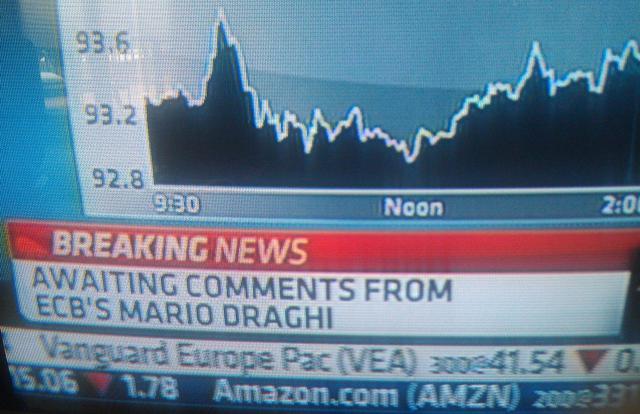�

Whether you’re an addict of some sort, an avid collector or someone who seeks thrills, most recognize that it begins to take more and more to get the same exhilarating jolt.
At some point the stimulation you used to crave starts to become less and less efficient at delivering the thrill.
And then it’s gone.
Sometimes you find yourself pining for what used to be simpler times, when excess wasn’t staring you in the face and you still knew how to enjoy a good thing.
We may have forgotten how to do that.
It’s a sad day when we can no longer derive pleasure from excess.
It seems that we’ve forgotten how to enjoy the idea of an expanding and growing economy, historically low interest rates, low unemployment and low prices.
How else can you explain the way the market has behaved for the past 6 months?
Yet something stimulated the stock market this past Thursday and Friday, just as had been the case the previous Thursday and Friday.
For most of 2016 and for a good part of 2015, the stimulus had been the price of oil. but more than often the case was that the price of oil didn’t stimulate the market, but rather sucked the life out of it.
We should have all been celebrating the wonders of cheap oil and the inability of OPEC to function as an evil cartel, but as the excess oil has just kept piling higher and higher the thrill of declining end user prices has vanished.
Good stimulus or bad stimulus, oil has taken center stage, although every now and then the debacles in China diverted our attention, as well.
Every now and then, as has especially been occurring in the past 2 weeks, there have been instances of oil coming to life and paradoxically re-animating the stock market. It was a 20% jump in the price of oil that fueled the late week rally in the final week of the January 2016 option cycle. The oil price rise has no basis in the usual supply and demand equation and given the recent dynamic among suppliers is only likely to lead to even more production.
It used to be, that unless the economy was clearly heading for a slowdown, a decreasing price of oil was seen as a boost for most everyone other than the oil companies themselves. But now, no one seems to be benefiting.
As the price of oil was going lower and lower through 2015, what should have been a good stimulus was otherwise.
However, what last Thursday and Friday may have marked was a pivot away from oil as the driver of the market, just as we had pivoted away from China’s excesses and then its economic and market woes.
At some point there has to be a realization that increasing oil prices isn’t a good thing and that may leave us with the worst of all worlds. A sliding market with oil prices sliding and then a sliding market with oil prices rising.
It seems like an eternity ago that the market was being handcuffed over worries that the FOMC was going to increase interest rates and another eternity ago that the market seemed to finally be exercising some rational judgment by embracing the rate rise, if only for a few days, just 2 months ago.
This week saw a return to those interest rate fears as the FOMC, despite a paucity of data to suggest inflation was at hand, didn’t do much to dispel the idea that “one and done” wasn’t their plan. The market didn’t like that and saw the prospects of an interest rate increase as a bad thing, even if reflecting improving economic conditions.
But more importantly, what this week also saw was the market returning to what had driven it for a few years and something that it never seemed to tire of celebrating.
That was bad news.
This week brought no good news, at all and the market liked that.
Negative interest rates in Japan? That has to be good, right?
A sluggish GDP, oil prices rising and unimpressive corporate earnings should have sent the market into a further downward spiral, but instead the idea that the economy wasn’t expanding was greeted as good news.
Almost as if the Federal Reserve still had some unspent ammunition to throw at the economy that would also serve to bolster stocks, as had been the case for nearly 6 years.
It’s not really clear how much more stimulus the Federal Reserve can provide and if investors are counting on a new and better high, they may in for a big disappointment.
As usual, the week’s potential stock selections are classified as being in the Traditional, Double Dip Dividend, Momentum or “PEE” categories.
I’m a little surprised that my brokerage firm didn’t call me last week, to see if I was still alive, because it was the second consecutive week of not having made a single trade.
Despite what seem to be bargain prices, I haven’t been able to get very excited about very many of the ones that have seemed alluring. Although this coming Monday may be the day to mark a real and meaningful bounce higher, the lesson of the past 2 months has been that any move higher has simply been an opportunity to get disappointed and wonder how you ever could have been so fooled.
I’m not overly keen on parting with any cash this week unless there some reason to believe that the back to back gains of last week are actually the start of something, even if that something is only stability and treading water.
Building a base is probably far more healthy than trying to quickly recover all that has been quickly lost.
With weakness still abounding I’m a little more interested in looking for dividends if putting cash to work.
This week, I’m considering purchases of Intel (INTC), MetLife (MET) and Pfizer (PFE), all ex-dividend this coming week.
With the latter two, however, there’s also that pesky issue of earnings, as MetLife reports earnings after the close of trading on its ex-dividend date and Pfizer reports earnings the day before its ex-dividend date.
MetLife has joined with the rest of the financial sector in having been left stunned by the path taken by interest rates in the past 2 months, as the 10 Year Treasury Note is now at its lowest rate in about 8 months.
It wasn’t supposed to be that way.
But if you believe that it can’t keep going that way, it’s best to ignore the same argument used in the cases of the price of
oil, coal and gold.
With MetLife near a 30 month low and going ex-dividend early in the week before its earnings are reported in the same day, there may be an opportunity to sell a deep in the money call and hope for early assignment, thereby losing the dividend, but also escaping the risk of earnings. In return, you may still be able to obtain a decent option premium for just a day or two of exposure.
The story of Pfizer’s proposed inversion is off the front pages and its stock price no longer reflects any ebullience. It reports earnings the morning of the day before going ex-dividend. That gives plenty of time to consider establishing a position in the event that shares either go lower or have relatively little move higher.
The option premium, however, is not very high and with the dividend considered the option market is expecting a fairly small move, perhaps in the 3-4% range. Because of that I might consider taking on the earnings risk and establishing a position in advance of earnings, perhaps utilizing an at the money strike price.
In that case, if assigned early, there is still a decent 2 day return. If not assigned early, then there is the dividend to help cushion the blow and possibly the opportunity to either be assigned as the week comes to its end or to rollover the position, if a price decline isn’t unduly large.
Intel had a nice gain on Friday and actually has a nice at the money premium. That premium is somewhat higher than usual, particularly during an ex-dividend week. As with Pfizer, even if assigned early, the return for a very short holding could be acceptable for some, particularly as earnings are not in the picture any longer.
As with a number of other positions considered this week, the liquidity of the options positions should be sufficient to allow some management in the event rollovers are necessary.
2015 has been nothing but bad news for American Express (AXP) and its divorce from Costco (COST) in now just a bit more than a month away.
The bad news for American Express shareholders continued last week after reporting more disappointing earnings the prior week. It continued lower even as its credit card rivals overcame some weakness with their own earnings reports during the week.
At this point it’s very hard to imagine any company specific news for American Express that hasn’t already been factored into its 3 1/2 year lows.
The weekly option premium reflects continued uncertainty, but I think that this is a good place to establish a position, either through a buy/write or the sale of puts. Since the next ex-dividend date is more than 2 months away, I might favor the sale of puts, however.�
Yahoo (YHOO) reports earnings this week and as important as the numbers are, there has probably been no company over the past 2 years where far more concern has focused on just what it is that Yahoo is and just what Yahoo will become.
Whatever honeymoon period its CEO had upon her arrival, it has been long gone and there is little evidence of any coherent vision.
In the 16 months since spinning off a portion of its most valuable asset, Ali Baba (BABA), it has been nothing more than a tracking stock of the latter. Ali Baba has gone 28.6% lower during that period and Yahoo 28% lower, with their charts moving in tandem every step of the way.
With Ali Baba’s earnings now out of the way and not overly likely to weigh on shares any further, the options market is implying a price move of 7.6%.
While I usually like to look for opportunities where I could possibly receive a 1% premium for the sale of puts at a strike price that’s outside of the lower boundary dictated by the option market, I very much like the premium at the at the money put strike and will be considering that sale.
The at the money weekly put sale is offering about a 4% premium. With a reasonably liquid option market, I’m not overly concerned about difficulty in being able to rollover the short puts in the event of an adverse move and might possibly consider doing so with a longer term horizon, if necessary.
Finally, there was a time that it looked as if consumers just couldn’t get enough of Michael Kors (KORS).
Nearly 2 years ago the stock hit its peak, while many were writing the epitaph of its competitor Coach (COH), at least Coach’s 23% decline in that time isn’t the 60% that Kors has plunged.
I haven’t had a position in Kors for nearly 3 years, but do still have an open position in Coach, which for years had been a favorite “go to” kind of stock with a nice dividend and a nice option premium.
Unfortunately, Coach, which had long been prone to sharp moves when earnings were announced, had lost its ability to recover reasonably quickly when the sharp moves were lower.
While Coach is one of those rare gainers in 2016, nearly 13% higher, Kors is flat on the year, although still far better than the S&P 500.
While I don’t believe that Coach has turned the tables on Kors and is now “eating their lunch” as was so frequently said when Kors was said to be responsible for Coach’s reversal of fortune, I think that there is plenty of consumer to go around for both.
Kors reports earnings this week and like COach, is prone to large earnings related moves.
With no dividend to factor into the equation, Kors may represent a good opportunity for those willing to take some risk and consider the sale of out of the money puts.
WIth an implied move of 8.5% next week, it may be possible to get a 1.1% ROI even if shares fall by as much as 11.3% during the week.
A $4.50 move in either direction is very possible with Kors after having dropped nearly $60 over the past 2 years. However, if faced with the possibility of assignment of shares, particularly since there is no dividend, I would just look for any opportunity to continue rolling the short puts over and over.
If not wanting to take the take the risk of a potential large drop, some consideration can also be given to selling puts after earnings, in the event of a large drop in shares. If that does occur, the premiums should still be attractive enough to consider making the sale of puts after the event.
Traditional Stocks: American Express
Momentum Stocks: none
Double-Dip Dividend: Intel (2/3 $0.26), MetLife (2/3 $0.38), Pfizer (2/3 $0.30)
Premiums Enhanced by Earnings: Michael Kors (2/2 AM), Yahoo (2/2 PM)
Remember, these are just guidelines for the coming week. The above selections may become actionable – most often coupling a share purchase with call option sales or the sale of covered put contracts – in adjustment to and consideration of market movements. The overriding objective is to create a healthy income stream for the week, with reduction of trading risk.
 Some days we really have no clue as to what made the market move as it did, but nothing bothers us more than not knowing the reasons for everything.
Some days we really have no clue as to what made the market move as it did, but nothing bothers us more than not knowing the reasons for everything.


 Depending upon what kind of outlook you have in life, the word “limbo” can conjure up two very different pictures.
Depending upon what kind of outlook you have in life, the word “limbo” can conjure up two very different pictures.


 At first glance there’s not too much to celebrate so far, as the first month of 2015 is now sealed and inscribed in the annals of history.
At first glance there’s not too much to celebrate so far, as the first month of 2015 is now sealed and inscribed in the annals of history. A quick glance at the S&P 500’s behavior over the past month certainly shows that uncertainty as reflected in the number of days with gap openings higher and lower, as well as the significant intra-day reversals seen throughout the month.
A quick glance at the S&P 500’s behavior over the past month certainly shows that uncertainty as reflected in the number of days with gap openings higher and lower, as well as the significant intra-day reversals seen throughout the month.

 This past week was one when neither decisions nor inputs were really required from investors as the market had its best week in about four months. With the exception of a totally inconsequential FOMC statement release, there was absolutely no economic news, or really no news of any kind at all. In fact, awaiting the scheduled remarks from Mario Draghi was elevated to the status of “breaking news” as most people were tiring of seeing celebrities getting doused with a bucket of ice, under the guise of being news.
This past week was one when neither decisions nor inputs were really required from investors as the market had its best week in about four months. With the exception of a totally inconsequential FOMC statement release, there was absolutely no economic news, or really no news of any kind at all. In fact, awaiting the scheduled remarks from Mario Draghi was elevated to the status of “breaking news” as most people were tiring of seeing celebrities getting doused with a bucket of ice, under the guise of being news.